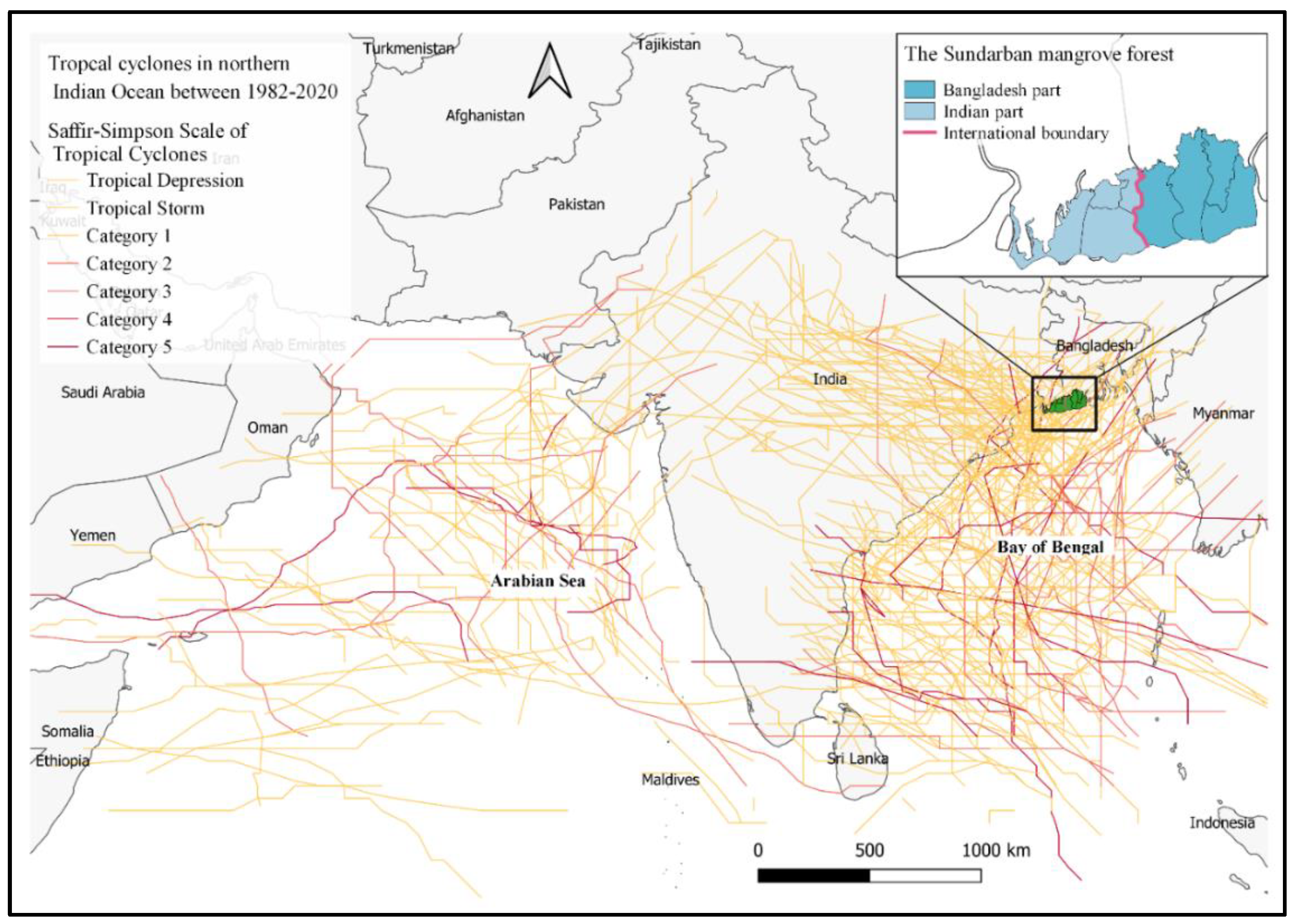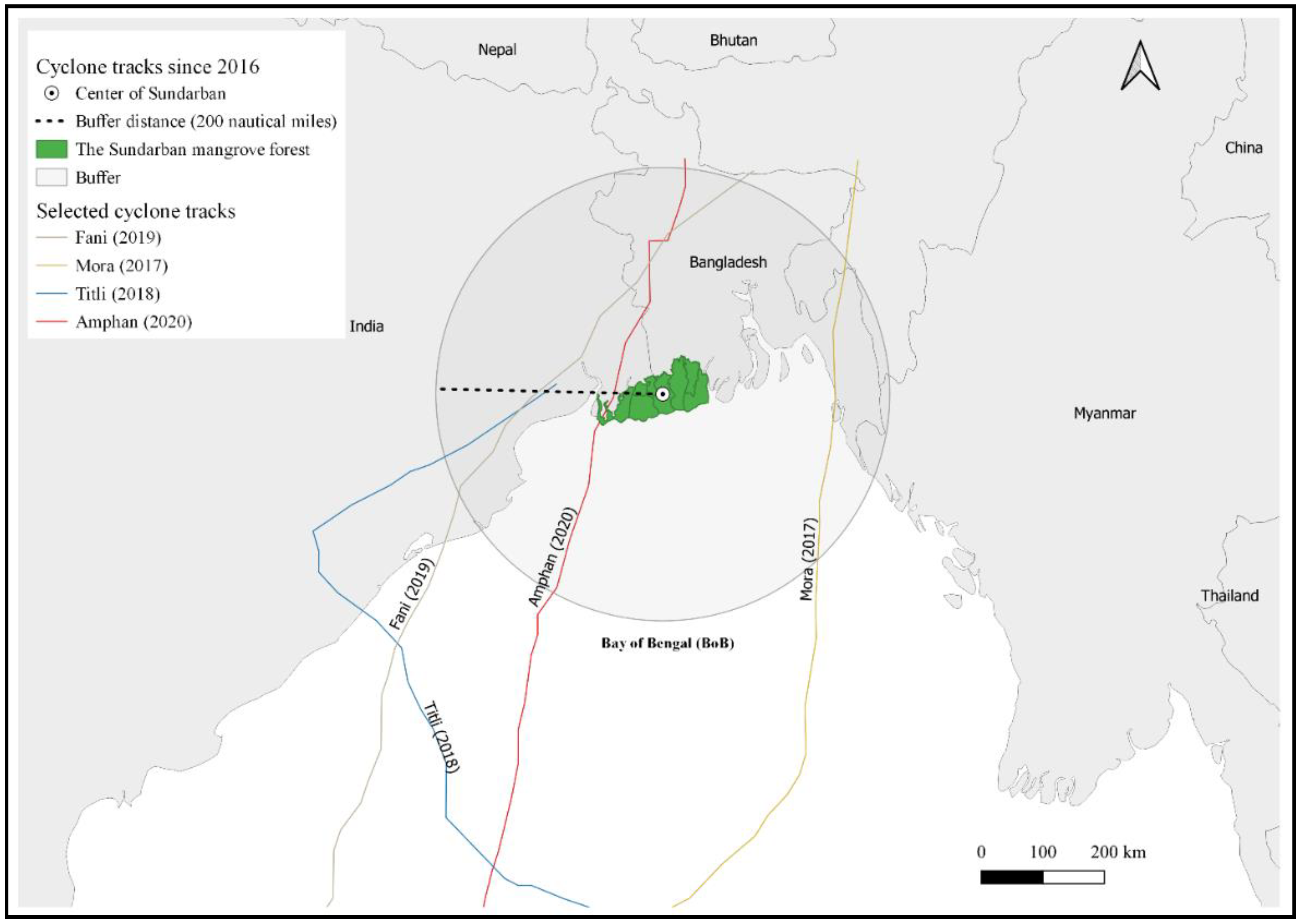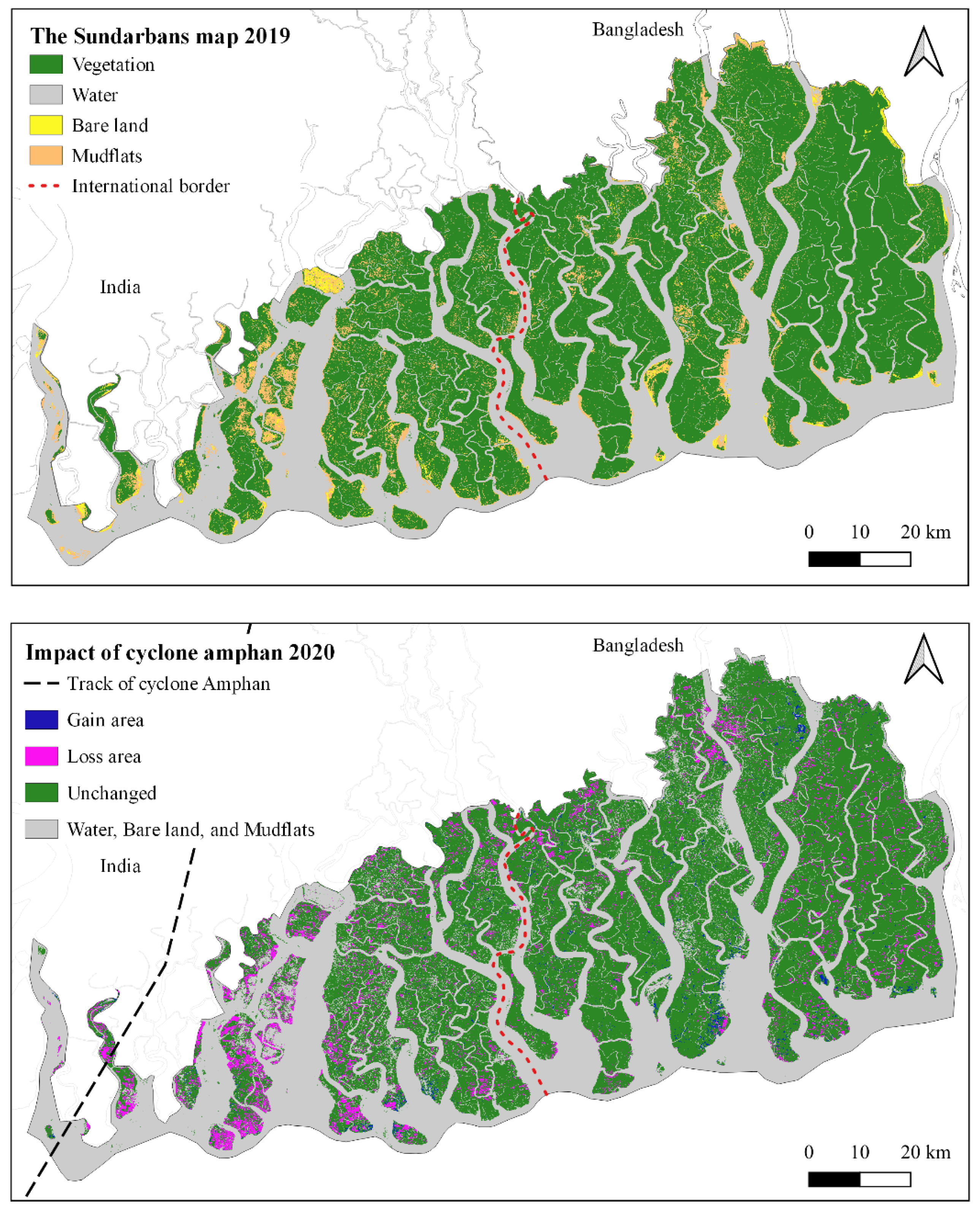Successive Cyclones Attacked the World’s Largest Mangrove Forest Located in the Bay of Bengal under Pandemic
Abstract
:1. Introduction
2. Materials and Methods
2.1. Study Area
2.2. Cyclone Data
2.3. Multi-Spectral Remote Sensing Data Analyses
2.4. Empirical Models to Validate the Impacts of Cyclones on NDVI Change
3. Results and Discussion
3.1. Rapid Detection of Mangrove Damage by Remote Sensing
3.2. Empirical Models of NDVI Changes
3.3. Importance of Timely Assessment, Pandemic and Points of Concern
4. Conclusions
Author Contributions
Funding
Data Availability Statement
Acknowledgments
Conflicts of Interest
References
- Mumby, P.J.; Vitolo, R.; Stephenson, D.B. Temporal Clustering of Tropical Cyclones and Its Ecosystem Impacts. Proc. Natl. Acad. Sci. USA 2011, 108, 17626–17630. [Google Scholar] [CrossRef] [PubMed] [Green Version]
- Mandal, M.S.H.; Hosaka, T. Assessing Cyclone Disturbances (1988–2016) in the Sundarbans Mangrove Forests Using Landsat and Google Earth Engine. Nat. Hazards 2020, 102, 133–150. [Google Scholar] [CrossRef]
- Paul, B.; Rashid, H. Climatic Hazards in Coastal Bangladesh: Non-Structural and Structural Solutions; Butterworth-Heinemann: Oxford, UK, 2016. [Google Scholar]
- Knutson, T.; Camargo, S.J.; Chan, J.C.; Emanuel, K.; Ho, C.-H.; Kossin, J.; Mohapatra, M.; Satoh, M.; Sugi, M.; Walsh, K.; et al. Tropical Cyclones and Climate Change Assessment: Part I: Detection and Attribution. Bull. Am. Meteorol. Soc. 2019, 100, 1987–2007. [Google Scholar] [CrossRef] [Green Version]
- Sánchez-Triana, E.; Paul, T.; Leonard, O. Building Resilience for Sustainable Development of the Sundarbans: Strategy Report; South Asia Region Sustainable Development Department Environment & Water Resources Management Unit, The Work Bank: Washington, DC, USA, 2014. [Google Scholar]
- Singh, O.; Khan, T.M.A.; Rahman, M.S. Has the Frequency of Intense Tropical Cyclones Increased in the North Indian Ocean? Curr. Sci. 2001, 80, 575–580. [Google Scholar]
- Balaguru, K.; Taraphdar, S.; Leung, L.R.; Foltz, G.R. Increase in the Intensity of Postmonsoon Bay of Bengal Tropical Cyclones. Geophys. Res. Lett. 2014, 41, 3594–3601. [Google Scholar] [CrossRef]
- Dare, R.A.; McBride, J.L. The Threshold Sea Surface Temperature Condition for Tropical Cyclogenesis. J. Clim. 2011, 24, 4570–4576. [Google Scholar] [CrossRef]
- World Meteorological Organization (WMO). Cyclone Amphan Highlights the Value of Multi-Hazard Early Warnings. Available online: https://public.wmo.int/en/media/news/cyclone-amphan-highlights-value-of-multi-hazard-early-warnings/ (accessed on 12 June 2020).
- The National Aeronautics and Space Administration (NASA). Tropical Cyclone Amphan. Available online: https://earthobservatory.nasa.gov/images/146746/tropical-cyclone-amphan (accessed on 12 June 2020).
- National Oceanic and Atmospheric Administration (NOAA). Tropical Cyclone Amphan Heads Toward India and Bangladesh. Available online: https://www.nesdis.noaa.gov/news/tropical-cyclone-amphan-heads-toward-india-and-bangladesh/ (accessed on 12 June 2020).
- India Meteorological Department (IMD). Regional Specialized Meteorological Centre for Tropical Cyclones over North Indian Ocean. Ministry of Earth Sciences, Government of India. Available online: http://www.rsmcnewdelhi.imd.gov.in/ (accessed on 12 June 2020).
- Primavera, J.; Dela Cruz, M.; Montilijao, C.; Consunji, H.; Dela Paz, M.; Rollon, R.; Maranan, K.; Samson, M.; Blanco, A. Preliminary Assessment of Post-Haiyan Mangrove Damage and Short-Term Recovery in Eastern Samar, Central Philippines. Mar. Pollut. Bull. 2016, 109, 744–750. [Google Scholar] [CrossRef]
- Spalding, M. World Atlas of Mangroves; Routledge: Oxfordshire, UK, 2010. [Google Scholar]
- Feagin, R.A.; Mukherjee, N.; Shanker, K.; Baird, A.H.; Cinner, J.; Kerr, A.M.; Koedam, N.; Sridhar, A.; Arthur, R.; Jayatissa, L.P.; et al. Shelter from the Storm? Use and Misuse of Coastal Vegetation Bioshields for Managing Natural Disasters. Conserv. Lett. 2010, 3, 1–11. [Google Scholar] [CrossRef] [Green Version]
- Barbier, E.B.; Hacker, S.D.; Kennedy, C.; Koch, E.W.; Stier, A.C.; Silliman, B.R. The Value of Estuarine and Coastal Ecosystem. Serv. Ecol. Monogr. 2011, 81, 169–193. [Google Scholar] [CrossRef]
- Krauss, K.W.; Osland, M.J. Tropical Cyclones and the Organization of Mangrove Forests: A Review. Ann. Bot. 2020, 125, 213–234. [Google Scholar] [CrossRef]
- Vincent, J.R.; Das, S. Reply to Baird et al.: Mangroves and Storm Protection: Getting the Numbers Right. Proc. Natl. Acad. Sci. USA 2009, 106, E112. [Google Scholar] [CrossRef] [Green Version]
- Danielsen, F.; Sørensen, M.K.; Olwig, M.F.; Selvam, V.; Parish, F.; Burgess, N.D.; Hiraishi, T.; Karunagaran, V.M.; Rasmussen, M.S.; Hansen, L.B.; et al. The Asian Tsunami: A Protective Role for Coastal Vegetation. Science 2005, 310, 643. [Google Scholar] [CrossRef] [PubMed] [Green Version]
- Ray, R.; Chowdhury, C.; Majumder, N.; Dutta, M.K.; Mukhopadhyay, S.K.; Jana, T.K. Improved Model Calculation of Atmospheric CO2 Increment in Affecting Carbon Stock of Tropical Mangrove Forest. Tellus B Chem. Phys. Meteorol. 2013, 65, 18981. [Google Scholar] [CrossRef]
- Rahman, A.F.; Dragoni, D.; El-Masri, B. Response of the Sundarbans Coastline to Sea Level Rise and Decreased Sediment Flow: A Remote Sensing Assessment. Remote Sens. Environ. 2011, 115, 3121–3128. [Google Scholar] [CrossRef]
- Giri, C.; Pengra, B.; Zhu, Z.; Singh, A.; Tieszen, L.L. Monitoring Mangrove Forest Dynamics of the Sundarbans in Bangladesh and India Using Multi-Temporal Satellite Data from 1973 to 2000. Estuar. Coast. Shelf Sci. 2007, 73, 91–100. [Google Scholar] [CrossRef]
- Sampath, V. India: National Report on the Status and Development Potential of the Coastal and Marine Environment of the East Coast of India and Its Living Resources. GEF/FAO Bay of Bengal Large Marine Ecosystem Programme. Open J. Ecol. 2003, 3, 296. [Google Scholar]
- Sippo, J.Z.; Sanders, C.J.; Santos, I.R.; Jeffrey, L.C.; Call, M.; Harada, Y.; Maguire, K.; Brown, D.; Conrad, S.R.; Maher, D.T. Coastal Carbon Cycle Changes Following Mangrove Loss. Limnol. Oceanogr. 2020, 65, 2642–2656. [Google Scholar] [CrossRef]
- Payo, A.; Mukhopadhyay, A.; Hazra, S.; Ghosh, T.; Ghosh, S.; Brown, S.; Nicholls, R.J.; Bricheno, L.; Wolf, J.; Kay, S.; et al. Projected Changes in Area of the Sundarban Mangrove Forest in Bangladesh Due to SLR by 2100. Clim. Change 2016, 139, 279–291. [Google Scholar] [CrossRef] [PubMed] [Green Version]
- Iftekhar, M.; Saenger, P. Vegetation Dynamics in the Bangladesh Sundarbans Mangroves: A Review of Forest Inventories. Wetl. Ecol. Manag. 2008, 16, 291–312. [Google Scholar] [CrossRef]
- Mandal, M.S.H.; Kamruzzaman, M.; Hosaka, T. Elucidating the Phenology of the Sundarbans Mangrove Forest Using 18-Year Time Series of MODIS Vegetation Indices. Tropics 2020, 29, 41–55. [Google Scholar] [CrossRef]
- Mandal, M.S.H. Remote Sensing of Mangrove Forest Dynamics in the Sundarbans. Ph.D. Thesis, Hiroshima University, Hiroshima, Japan, 2020. [Google Scholar]
- UIA World Countries Boundaries. ArcGIS Hub. Available online: https://hub.arcgis.com/datasets/UIA::uia-world-countries-boundaries/data/ (accessed on 10 June 2020).
- Gorelick, N.; Hancher, M.; Dixon, M.; Ilyushchenko, S.; Thau, D.; Moore, R. Google Earth Engine: Planetary-Scale Geospatial Analysis for Everyone. Remote Sens. Environ. 2017, 202, 18–27. [Google Scholar] [CrossRef]
- Hladik, C.; Alber, M. Classification of Salt Marsh Vegetation Using Edaphic and Remote Sensing-Derived Variables. Estuar. Coast. Shelf Sci. 2014, 141, 47–57. [Google Scholar] [CrossRef]
- Chambers, J.Q.; Fisher, J.I.; Zeng, H.; Chapman, E.L.; Baker, D.B.; Hurtt, G.C. Hurricane Katrina’s Carbon Footprint on US Gulf Coast Forests. Science 2007, 318, 1107. [Google Scholar] [CrossRef] [PubMed] [Green Version]
- Feng, Y.; Negrón-Juárez, R.I.; Chambers, J.Q. Remote Sensing and Statistical Analysis of the Effects of Hurricane María on the Forests of Puerto Rico. Remote Sens. Environ. 2020, 247, 111940. [Google Scholar] [CrossRef]
- Berlanga-Robles, C.A.; Ruiz-Luna, A. Assessing Seasonal and Long-Term Mangrove Canopy Variations in Sinaloa, Northwest Mexico, Based on Time Series of Enhanced Vegetation Index (EVI) Data. Wetl. Ecol. Manag. 2020, 28, 229–249. [Google Scholar] [CrossRef]
- Carlson, T.N.; Ripley, D.A. On the Relation between NDVI, Fractional Vegetation Cover, and Leaf Area Index. Remote Sens. Environ. 1997, 62, 241–252. [Google Scholar] [CrossRef]
- Zhang, K.; Thapa, B.; Ross, M.; Gann, D. Remote Sensing of Seasonal Changes and Disturbances in Mangrove Forest: A Case Study from South Florida. Ecosphere 2016, 7, e01366. [Google Scholar] [CrossRef] [Green Version]
- Taillie, P.J.; Roman-Cuesta, R.; Lagomasino, D.; Cifuentes-Jara, M.; Fatoyinbo, T.; Ott, L.E.; Poulter, B. Widespread Mangrove Damage Resulting from the 2017 Atlantic Mega Hurricane Season. Environ. Res. Lett. 2020, 15, 064010. [Google Scholar] [CrossRef]
- Charrua, A.B.; Padmanaban, R.; Cabral, P.; Bandeira, S.; Romeiras, M.M. Impacts of the Tropical Cyclone Idai in Mozambique: A Multi-Temporal Landsat Satellite Imagery Analysis. Remote Sens. 2021, 13, 201. [Google Scholar] [CrossRef]
- R Core Team. R: A Language and Environment for Statistical Computing; R Foundation for Statistical Computing: Vienna, Austria, 2022; Available online: https://cran.r-project.org/ (accessed on 18 January 2022).
- QGIS.org. QGIS Geographic Information System. 2020. Available online: https://www.qgis.org/en/site/ (accessed on 18 January 2022).
- Kamimura, Y.; Shoji, J. Does Macroalgal Vegetation Cover Influence Post-Settlement Survival and Recruitment Potential of Juvenile Black Rockfish Sebastes Cheni? Estuar. Coast. Shelf Sci. 2013, 129, 86–93. [Google Scholar] [CrossRef]
- Sharma, S.; Hoque, A.R.; Analuddin, K.; Hagihara, A. Litterfall Dynamics in an Overcrowded Mangrove Kandelia Obovata (S., L.) Yong Stand over Five Years. Estuar. Coast. Shelf Sci. 2012, 98, 31–41. [Google Scholar] [CrossRef]
- Villamayor, B.M.R.; Rollon, R.N.; Samson, M.S.; Albano, G.M.G.; Primavera, J.H. Impact of Haiyan on Philippine Mangroves: Implications to the Fate of the Widespread Monospecific Rhizophora Plantations against Strong Typhoons. Ocean. Coast. Manag. 2016, 132, 1–14. [Google Scholar] [CrossRef]
- Aung, T.T.; Mochida, Y.; Than, M.M. Prediction of Recovery Pathways of Cyclone-Disturbed Mangroves in the Mega Delta of Myanmar. For. Ecol. Manag. 2013, 293, 103–113. [Google Scholar] [CrossRef]
- Pannet, R.; Miller, M.E.; Vinall, F. Tonga Races to Prevent a ‘Tsunami of Covid’ as Rescue Efforts Begin after Underwater Volcano Disaster. Washington Post, 18 January 2022. [Google Scholar]
- Walton, M.E.; Samonte-Tan, G.P.; Primavera, J.H.; Edwards-Jones, G.; Le Vay, L. Are Mangroves Worth Replanting? The Direct Economic Benefits of a Community-Based Reforestation Project. Environ. Conserv. 2006, 33, 335–343. [Google Scholar] [CrossRef]





| Code | Name | Date | Category | Distance (km) | Wind Speed (km h−1) | Detected Area km2 (% of Damage) |
|---|---|---|---|---|---|---|
| C88 | 04B | 28–29 November 1988 | H3 | 24 | 204 | 1093 (20.4) |
| C89 | Unnamed | 23–26 May 1989 | TS | 200 | 102 | 25 (0.5) |
| C90 | BOB 09/04B | 17–19 December 1990 | TS | 210 | 83 | 24(0.5) |
| C91 | Gorky | 29–30 April 1991 | H4 | 160 | 241 | 432 (8.1) |
| C92 | Unnamed | 22–24 September 1992 | TD | 33 | 56 | 93 (1.7) |
| C94 | Unnamed | 2 May 1994 | H3 | 328 | 204 | 418 (7.8) |
| C95 | Unnamed | 24–25 November 1995 | H2 | 255 | 157 | 659 (12.3) |
| C96 | Unnamed | 28 October 1996 | TD | 34 | 74 | 61 (1.1) |
| C97 | Unnamed | 18–19 May 1997 | H1 | 243 | 120 | 281 (5.3) |
| C98 | Unnamed | 18–20 May 1998 | H1 | 210 | 130 | 166 (3.1) |
| C99 | Unnamed | 8–11 June 1999 | TS | 123 | 65 | 336 (6.3) |
| C00 | Unnamed | 27–28 October 2000 | TS | 52 | 65 | 78 (1.5) |
| C02 | Unnamed | 12 November 2002 | TS | 94 | 102 | 29 (0.6) |
| C04 | Unnamed | 15–18 May 2004 | H1 | 303 | 120 | 300 (5.6) |
| C05 | Unnamed | 1–3 October 2005 | TS | 115 | 74 | 279 (5.2) |
| C06 | Unnamed | 30 June–5 July 2007 | TS | 160 | 65 | 441 (8.2) |
| C07 | Sidr | 15–16 November 2007 | H5 | 59 | 259 | 1291 (24.1) |
| C08 | Rashmi | 25–26 October 2008 | TS | 59 | 83 | 258 (4.8) |
| C09 | Aila | 25–26 May 2009 | H2 | 122 | 120 | 53 (1) |
| C15 | Komen | 26 June–2 August 2015 | TS | 116 | 46 | 137 (2.6) |
| C16 | Roanu | 20–21 May 2016 | TS | 106 | 116 | 152 (2.9) |
| C17 | Mora | 28–30 May 2017 | TS | 281 | 111 | 17.9 (0.3) |
| C18 | Titli | 8–12 October 2018 | H1 | 10 | 148 | 31.2 (0.5) |
| C19 | Fani | 26 April–4 May 2019 | H4 | 146 | 213 | 66 (1.1) |
| C20 | Amphan | 16–21 May 2020 | H4 | 81 | 241 | 550.1 (11.5) |
| No | Class | Area (km2) | Producer’s Accuracy | Consumer’s Accuracy |
|---|---|---|---|---|
| 1 | Vegetation | 6077.37 | 0.99 | 0.78 |
| 2 | Water | 3855.14 | 0.88 | 0.96 |
| 3 | Mudflat | 624.16 | 0.71 | 0.83 |
| 4 | Bare soil | 117.80 | 0.54 | 0.86 |
| Total area | 10,674.47 | |||
| Overall accuracy | 0.86% | |||
| Kappa coefficient | 0.79 |
| Coefficients | Mean | (95% CI) | p |
|---|---|---|---|
| Intercept | −9.82 × 10−2 | (−9.87 × 10−2 to −9.76 × 10−2) | <0.001 |
| Track | 7.40 × 10−3 | (7.37 × 10−2 to 7.43 × 10−3) | <0.001 |
| Water | 7.02 × 10−5 | (3.93 × 10−5 to 10.10 × 10−5) | <0.01 |
| preNDVI | 1.91 × 10−1 | (0.19 to 0.20) | <0.001 |
Publisher’s Note: MDPI stays neutral with regard to jurisdictional claims in published maps and institutional affiliations. |
© 2022 by the authors. Licensee MDPI, Basel, Switzerland. This article is an open access article distributed under the terms and conditions of the Creative Commons Attribution (CC BY) license (https://creativecommons.org/licenses/by/4.0/).
Share and Cite
Sharma, S.; Suwa, R.; Ray, R.; Mandal, M.S.H. Successive Cyclones Attacked the World’s Largest Mangrove Forest Located in the Bay of Bengal under Pandemic. Sustainability 2022, 14, 5130. https://doi.org/10.3390/su14095130
Sharma S, Suwa R, Ray R, Mandal MSH. Successive Cyclones Attacked the World’s Largest Mangrove Forest Located in the Bay of Bengal under Pandemic. Sustainability. 2022; 14(9):5130. https://doi.org/10.3390/su14095130
Chicago/Turabian StyleSharma, Sahadev, Rempei Suwa, Raghab Ray, and Mohammad Shamim Hasan Mandal. 2022. "Successive Cyclones Attacked the World’s Largest Mangrove Forest Located in the Bay of Bengal under Pandemic" Sustainability 14, no. 9: 5130. https://doi.org/10.3390/su14095130
APA StyleSharma, S., Suwa, R., Ray, R., & Mandal, M. S. H. (2022). Successive Cyclones Attacked the World’s Largest Mangrove Forest Located in the Bay of Bengal under Pandemic. Sustainability, 14(9), 5130. https://doi.org/10.3390/su14095130






